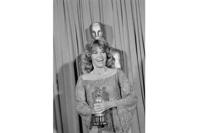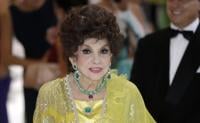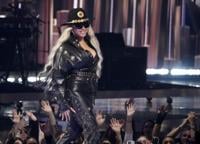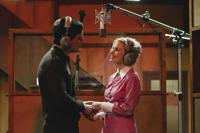“Me love you long time,” a Vietnamese sex worker tells the U.S. troops, swiveling her hips as she hawks her services. “You party?” The first female character in Stanley Kubrick’s Vietnam War classic “Full Metal Jacket,” she appears for just a moment — and halfway through the film.
Likewise, it’s an hour into when a helicopter suddenly deposits three women onto a stage. They're scantily clad Playboy Bunnies, choppered in to rile up the troops. They, too, appear for just a few minutes.
The Vietnam War produced some of the most unforgettable films of the late 1970s and 1980s, as top Hollywood filmmakers like , , Oliver Stone and others grappled with its painful legacy. Few, however, had classic, or even three-dimensional, female characters — with the notable exception of “Coming Home,” which won an Oscar.
But while these films were almost exclusively about how war dehumanized men — with female characters mere devices to tell that story — the opposite was often true of Vietnamese films about the conflict. Many of these were told from a female viewpoint — the stories of brave and loyal women, for example, left to hold families together.
Here are some ways that used female characters to tell their stories:
The girl waiting back home
focuses on three lifelong buddies from a Pennsylvania steel town who go off to fight, with traumatic results.
Since the 1978 drama starts and ends at home, there’s room for a female character in Meryl Streep’s Linda, girlfriend of Nick (Christopher Walken) who also connects with Michael (Robert De Niro). An early-career Streep was such a magnetic presence as Linda — earning an Oscar nomination — that it disguised a fairly thin role that mainly advanced the men's narrative.
A rare contrast was Hal Ashby’s “Coming Home” the same year, in which Fonda and Jon Voight both won Oscars for the tale of a Marine wife embroiled in an intense affair with a wounded veteran at the rehab center where she volunteers.
“This is the only Hollywood film set during the Vietnam War that’s told from the point of view of a female character,” says filmmaker Tony Bui, who also teaches Vietnam War cinema at Columbia University. “That's really saying something.”
Village extras and Playboy Bunnies
Its tortured journey to the screen is a drama in itself, but 1979's “Apocalypse Now,” with Martin Sheen as an army captain tasked with assassinating a renegade U.S. colonel (Marlon Brando), is considered a masterpiece of the genre. As in many Hollywood Vietnam films, women are extras in villages, screaming and running from gunfire and deadly explosions — or killed brutally for no reason at all.
Then there are the Playboy Bunnies, who gyrate to “Suzy Q” as the troops become increasingly frenzied with erotic excitement and eventually storm the stage.
Lan Duong, assistant professor of cinema studies at the University of Southern California, sees Coppola trying to make a connection between sex, warfare and masculinity.
“With American white women in particular, they’re seen as part of the American mythology around manhood,” Duong says. Full-blooded manhood with raging hormones, she says, is “as American as apple pie.”
The enemy dehumanized
In 1986's “Platoon,” Stone's Oscar-winning depiction of jungle warfare, representation of women comes in a horrific scene in which U.S. troops kills hundreds of innocent villagers, evoking the During the slaughter, idealistic soldier Chris (Charlie Sheen) comes upon soldiers raping young women. “She’s a human being!” he screams. They reply: “You don’t belong in ’Nam, man.”
These women are given no voice. They appear “only in relation to the violence inflicted by men,” Bui says.
In Brian de Palma’s “Casualties of War” (1989), the tragic rape victim actually becomes a central character in the plot. This does not mean, however, that we learn much of anything about this Vietnamese girl (Thuy Thu Le).
Based on a real event, the film follows five soldiers whose leader (Sean Penn) devises a sickening plan: The group will kidnap a young girl for “recreation” during a mission.
Only Pvt. Eriksson (Michael J. Fox) objects. The four others not only rape the girl, but eventually pump her with bullets. Eriksson takes the case to superiors, who advise him to drop it. But Eriksson persists, and the men earn punishment.
Though important, this brutalized girl is again voiceless. “She goes from suffering, to suffering more, and then gets killed — that’s her arc,” says Bui, who includes the movie in a he has curated on Vietnam films.
Sex workers and snipers
Kubrick’s memorable 1987 “Full Metal Jacket” contains two brief, stereotypical scenes involving sex workers. But the most interesting scene involving a female character comes during battle, where a sniper targeting U.S. troops turns out to be a terrified girl in pigtails. As she lies mortally wounded, she begs quietly, “Shoot me.” The soldiers oblige.
The stereotypical nature of the sex worker scenes is, for Bui, redeemed somewhat by the character of the sniper (Ngoc Le), whose courage is acknowledged.
In Bui's own “Three Seasons,” a 1999 Vietnamese-American production, sex worker Lan (Diep Bui) is central to the story, an exploration of postwar life in Ho Chi Minh City. A cyclo driver falls in love with Lan and trails her around the city, trying to help her find a better life.
Widows and orphans
Bui says his research has found that more than half of Vietnamese films about the conflict have female protagonists. One of the most famous, Hải Ninh’s landmark “The Little Girl of Hanoi” (1974), follows a young girl (Lan Hương) searching for her family in bombed-out Hanoi.
Another, Đặng Nhật Minh’s “When the Tenth Month Comes” (1984), tells the story of Duyen (Lê Vân), a young wife and mother in the rural north whose husband goes to war. Her ailing father-in-law asks frequently why the soldier has not written home. Duyen learns one day that her husband's been dead for a year and enlists a local schoolteacher to help her hide that by forging eloquent letters.
The character is emblematic of the way Vietnamese culture has long portrayed the woman: fierce, loyal and resilient in the face of adversity, argues Duong.
“She is beautiful. She’s suffering. She’s loyal to the memory of her dead husband,” notes Duong. “It’s been argued by Đặng Nhật Minh himself ... that she's a symbol for the nation itself. So it becomes a really rich metaphor for filmmakers.”
The risk, she adds, is that such characters, serving as symbols, can also lack dimension.
Stone's change of focus
Stone is one of the only directors to have explicitly addressed the minimal role of women in his Vietnam works, saying “Platoon” was deliberately a male-driven narrative.
But with his third and last Vietnam War film, “Heaven & Earth” (1993), Stone shifted to the perspective of a real-life Vietnamese woman: Le Ly (Hiep Thi Le), who endures rape and torture as a young woman, then moves to California with her troubled American military husband (Tommy Lee Jones).
“There is some truth to the criticism of my treatment of women,” while making the film. “I have a lot to learn about everything, not just women.”
Making his point crystal clear, Stone dedicates the film at the end to his mother, Jacqueline Stone.










































